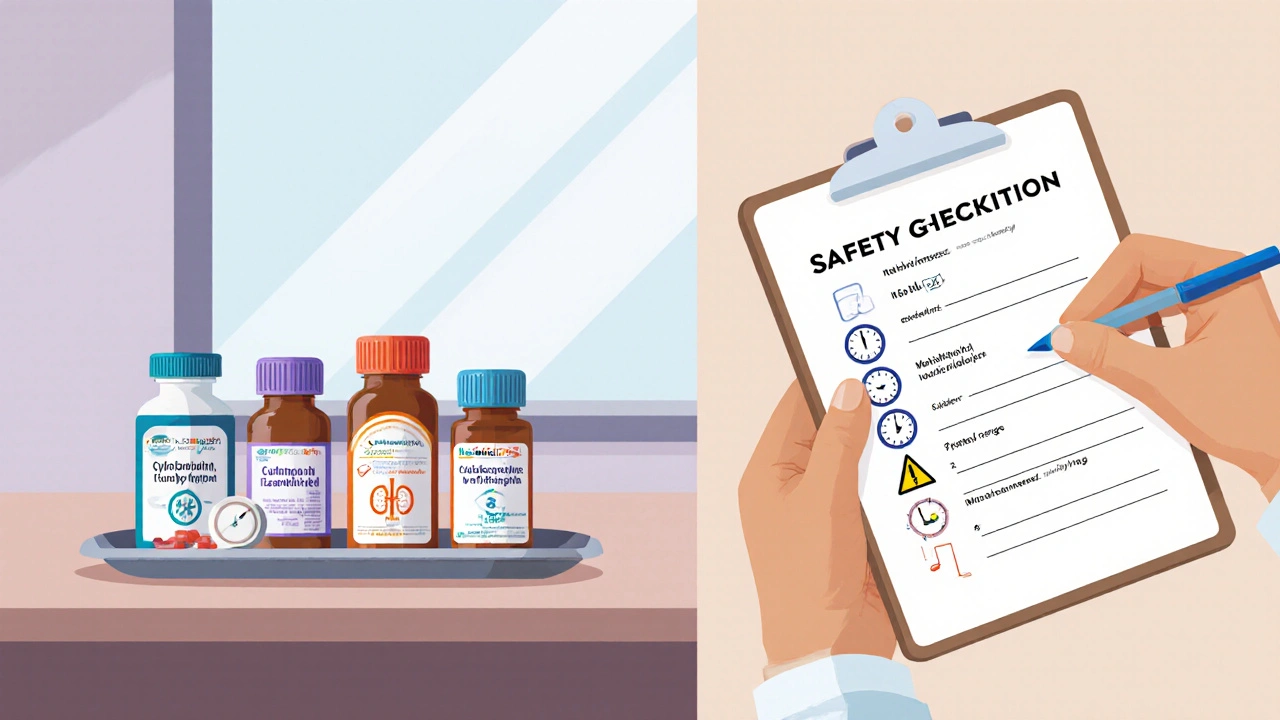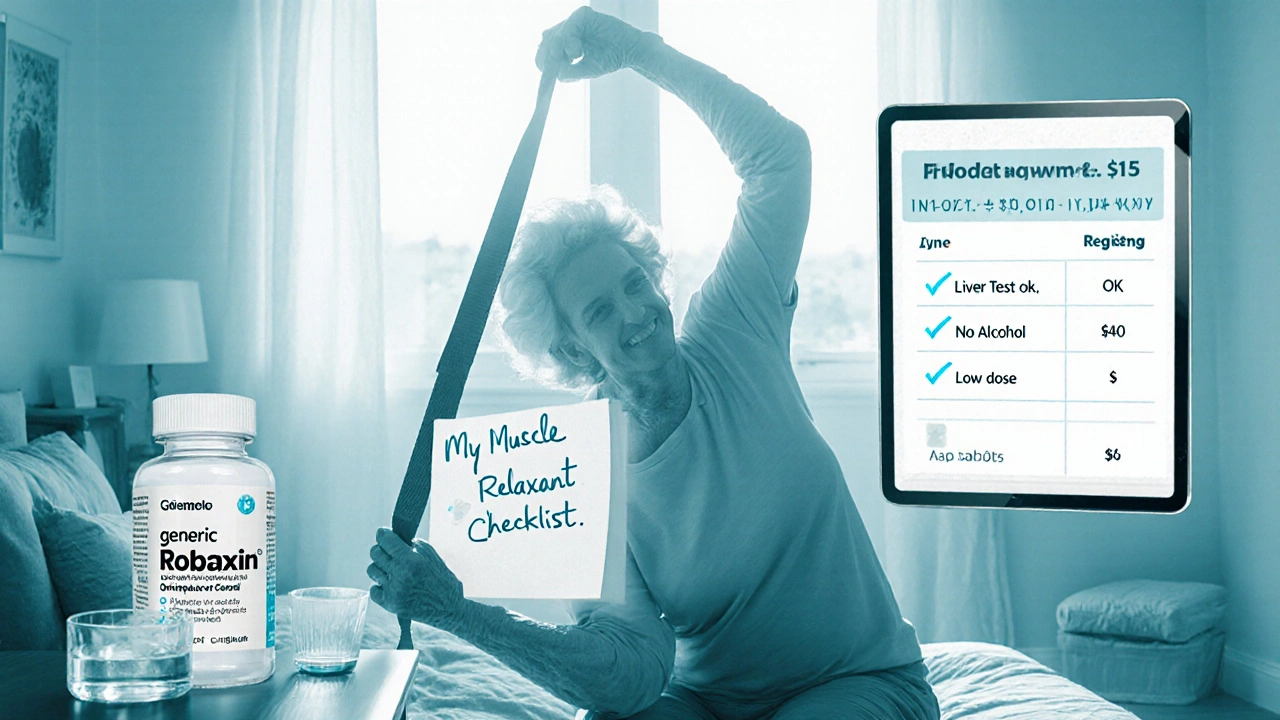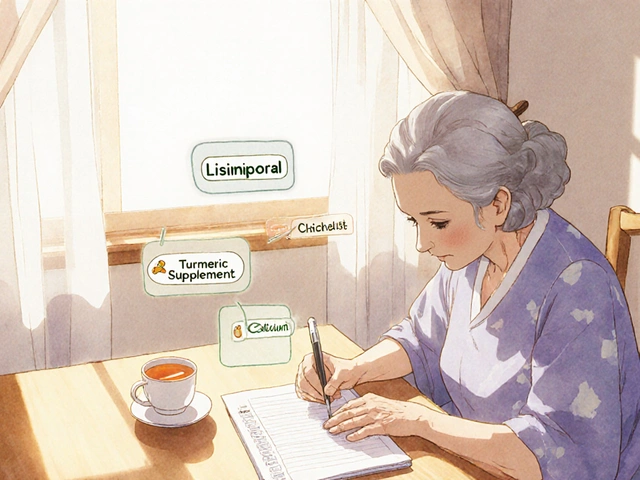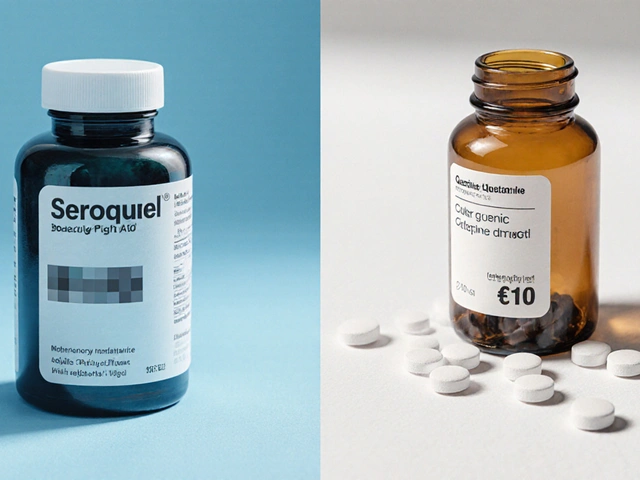Key Takeaways
- Robaxin (Methocarbamol) works by depressing central nervous system activity, not by acting directly on muscles.
- Typical alternatives include cyclobenzaprine, baclofen, tizanidine, and carisoprodol, each with its own onset, duration, and side‑effect profile.
- Choosing the right relaxant depends on the injury type, patient age, comorbidities, and how quickly pain relief is needed.
- Non‑drug options such as NSAIDs, physical therapy, or acupuncture can complement or replace muscle relaxants for many patients.
- Always check contraindications - especially liver disease for Robaxin and seizure history for baclofen - before starting any regimen.
When a doctor orders Robaxin (Methocarbamol), the goal is to calm the nervous system enough to ease muscle spasms that follow strains, sprains, or back injuries. Unlike some relaxants that bind to specific receptors in the spinal cord, Methocarbamol depresses overall central nervous system activity, which explains its relatively fast onset (often within 30 minutes) and modest side‑effect load.
Robaxin is frequently paired with NSAIDs or acetaminophen to tackle both muscle tension and the underlying inflammation. However, it’s not the only option on the shelf. Below we break down how it stacks up against the most common alternatives, the contexts where each shines, and the practical pitfalls you’ll want to dodge.
How Robaxin Works - Mechanism and Core Attributes
Methocarbamol’s exact mechanism remains partially mysterious, but studies suggest it interferes with polysynaptic reflexes in the spinal cord, dampening the signal that tells muscles to contract. Key attributes include:
- Class: Central muscle relaxant
- Typical adult dosage: 1500mg four times daily for the first 48hours, then 1000mg three times daily
- Onset: 30-60minutes
- Duration of effect: 4-6hours
- Common side effects: Drowsiness, dizziness, stomach upset
- Major contraindications: Severe liver disease, known hypersensitivity
Because it’s metabolized by the liver, patients with hepatitis or cirrhosis need dose adjustments or an entirely different agent.
Top Alternatives - Quick Snapshot
Here’s a rapid look at the four muscle relaxants you’ll most often see prescribed alongside-or instead of-Robaxin.
| Drug | Class | Typical Dosage | Onset | Duration | Common Side Effects | Key Contraindications |
|---|---|---|---|---|---|---|
| Cyclobenzaprine | Central‑acting | 5-10mg three times daily | 30-60min | 8-12hr | Drowsiness, dry mouth, constipation | Recent MI, arrhythmias, MAO‑inhibitor use |
| Baclofen | GABA‑B agonist | 5-10mg three times daily (titrated up) | 1-2hr | 4-6hr | Weakness, dizziness, hypotension | Seizure disorder, renal failure |
| Tizanidine | α2‑adrenergic agonist | 2mg up to 4mg three times daily | 30-60min | 2-3hr | Dry mouth, sedation, liver enzyme rise | Severe hepatic impairment |
| Carisoprodol | Central‑acting (pro‑drug of meprobamate) | 250‑350mg three times daily (max 3g) | 30min | 4-6hr | Drowsiness, dependence, withdrawal | History of substance abuse, pregnancy |
| NSAIDs (e.g., ibuprofen) | Non‑steroidal anti‑inflammatory | 400-800mg every 6-8hr | 15-30min | 4-6hr | GI upset, renal strain, cardiovascular risk | Peptic ulcer disease, severe CKD |
When Robaxin Is the Right Choice
If you need a muscle relaxant that kicks in quickly, lasts a moderate length of time, and has a relatively low risk of severe cardiac effects, Robaxin is a solid pick. It works well for:
- Acute low‑back strain after a heavy lift
- Neck spasms caused by poor ergonomics
- Short‑term postoperative muscle tension (when opioid use is minimized)
Because the drug is metabolized primarily by the liver, patients with mild to moderate hepatic impairment can often stay on a reduced dose, whereas many alternatives (especially baclofen) require renal dosing adjustments.

Scenarios Where an Alternative Might Beat Robaxin
Every muscle relaxant has a niche where it outperforms the rest. Here are the most common “win‑cases” for each competitor:
Cyclobenzaprine - The Long‑Acting Powerhouse
For patients who need overnight coverage, cyclobenzaprine’s 8-12‑hour window can reduce the need for a mid‑night dose. However, its anticholinergic side effects (dry mouth, constipation) make it a poor fit for older adults with prostate enlargement or glaucoma.
Baclofen - Ideal for Spasticity
When the underlying problem is neurologic spasticity (multiple sclerosis, spinal cord injury), baclofen’s GABA‑B agonism directly reduces muscle tone. It can be titrated to high doses, but abrupt withdrawal may trigger seizures, so a taper plan is essential.
Tizanidine - Quick‑Onset, Short‑Duration Option
For athletes who need a rapid “off‑the‑field” fix before a game, tizanidine’s 2‑hour effect window provides relief without lingering sedation. Liver function must be monitored, though, because the drug is hepatically cleared.
Carisoprodol - When Dependency Isn’t a Concern
In short‑term, low‑dose scenarios where a patient has previously tolerated meprobamate, carisoprodol can give stronger muscle relaxation. The downside is its potential for dependence, which limits its use to a few days.
NSAIDs - The Non‑Drug First Line
For many mild to moderate strains, an NSAID alone (or combined with a low‑dose muscle relaxant) can control pain and inflammation without the CNS‑depressant effects of drugs like Robaxin. Gastro‑protective strategies (e.g., adding a PPI) become important for high‑risk patients.
Safety Checklist - What to Verify Before Starting
- Review liver function tests (AST, ALT, bilirubin) especially for Robaxin and tizanidine.
- Check kidney function (eGFR) if considering baclofen or high‑dose NSAIDs.
- Ask about current medications - avoid concurrent MAO‑inhibitors with cyclobenzaprine and avoid other CNS depressants (benzodiazepines, opioids) to prevent excessive sedation.
- Screen for history of substance use disorder before prescribing carisoprodol.
- Confirm pregnancy status - most muscle relaxants are Category C; safer options like acetaminophen are preferred.
Following this checklist can dramatically cut the risk of adverse events and ensure the chosen drug aligns with the patient’s overall health picture.
Practical Tips for Patients - Getting the Most Out of Your Prescription
- Take the first dose with food to minimize stomach upset.
- Avoid alcohol; it magnifies drowsiness and can impair coordination.
- Plan activities that require alertness (driving, operating machinery) for after the medication’s peak effect wears off.
- Combine medication with gentle stretching or physical therapy - studies show a 30% faster return to normal function when both are used together.
- If side effects persist beyond a week, contact your prescriber for a possible dose reduction or switch.

Cost Considerations - Insurance, Generics, and Out‑of‑Pocket Pricing
Robaxin is available as a brand‑name tablet and a generic version (methocarbamol). In 2025, the average retail price for a 30‑day supply of the generic is $12‑$18, while brand‑name can reach $45. Cyclobenzaprine generic averages $8‑$12, baclofen $10‑$15, tizanidine $10‑$13, and carisoprodol $15‑$22. NSAIDs are typically under $5 for a month’s supply.
Most private insurers cover the generic forms with a modest co‑pay. Medicare Part D often lists methocarbamol under Tier2, meaning a slightly higher co‑pay than standard generics but lower than brand‑name. Always ask the pharmacy for “generic methocarbamol” to keep costs down.
Bottom Line - How to Choose Wisely
Pick Robaxin when you need rapid relief, have a healthy liver, and want a moderate duration without a strong anticholinergic load. Reach for cyclobenzaprine if overnight control is crucial and the patient has no cardiac risk factors. Baclofen shines for neurological spasticity, tizanidine for short‑burst needs, and carisoprodol only in short‑term, low‑dependence scenarios. Never forget that NSAIDs, physical therapy, and lifestyle changes can often replace or supplement a muscle relaxant, saving money and side‑effects.
Frequently Asked Questions
How quickly does Robaxin start working?
Most patients notice a reduction in muscle tightness within 30‑60 minutes after the first dose, especially when taken with food.
Can I take Robaxin with ibuprofen?
Yes, combining a central muscle relaxant like Robaxin with an NSAID such as ibuprofen is a common strategy to address both spasm and inflammation. Monitor for stomach upset and avoid excess alcohol.
What are the biggest side effects of methocarbamol?
The most frequently reported effects are drowsiness, dizziness, and mild gastrointestinal discomfort. Rarely, patients experience blurred vision or a drop in blood pressure.
Is Robaxin safe for older adults?
It can be used in seniors, but start at the lowest effective dose because older adults are more prone to sedation and falls. Assess liver function before prescribing.
How does cyclobenzaprine differ from methocarbamol?
Cyclobenzaprine is also a central relaxant but has a longer half‑life (up to 12hours) and a stronger anticholinergic profile, which can cause dry mouth and constipation. Methocarbamol’s shorter action makes it easier to manage dosing schedules.
Can I stop taking Robaxin abruptly?
Abrupt discontinuation is generally safe for methocarbamol because it does not cause physical dependence. However, tapering over a few days can minimize rebound muscle stiffness.







18 Comments
Well, this article tries to sound like a PhD dissertation but ends up being a bland sales brochure for generic meds. The writer bounces between vague buzzwords and half‑baked tables, making it hard to trust any of the recommendations. Anyone reading this should double‑check the dosing schedules because they’re off‑by‑one in a few places. And the side‑effect list? It’s basically a copy‑paste from the FDA label without any context. Bottom line: not the most useful deep dive you’d hope for.
The breakdown of each muscle relaxant is solid, especially the clear tables that help compare onset and duration. I appreciate the practical tips about pairing NSAIDs with a central relaxant – that’s often overlooked. The caution about liver function for Robaxin is spot‑on and crucial for safe prescribing. Overall, this is a very helpful resource for clinicians and patients alike.
Wow!! This post really nails the essential differences between the meds – so many useful nuggets! I especially love the part about the “quick‑off” nature of tizanidine for athletes – that's a game‑changer. The safety checklist is a lifesaver; I always forget to double‑check liver labs before starting Robaxin. Great job making complex pharmacology feel approachable!!
The article provides a concise, formal comparison of muscle relaxants, adhering to clinical standards without superfluous language.
Mate, this write‑up is a feast of pharmacologic fireworks – dazzling, colourful, and oddly flamboyant! It splashes the page with bold claims about liver safety, then backs them up with stats that glitter like gold. If you’re after a spicy, no‑holds‑barred rundown, you’ve hit the jackpot.
Reading through this exhaustive comparison, one cannot help but feel the weight of responsibility borne by prescribing physicians, tasked as they are with navigating a labyrinthine landscape of pharmacodynamics, pharmacokinetics, and patient‑specific nuances. The author wisely emphasizes liver function testing before initiating methocarbamol, a reminder that the organ’s detoxifying prowess can be a silent gatekeeper, determining whether a drug’s benefits eclipse its potential toxicity. Moreover, the distinction drawn between central‑acting agents and GABA‑B agonists foregrounds the diversity of mechanisms, urging clinicians to match the drug’s action to the underlying pathology – whether it be acute spasm or chronic spasticity. It is also noteworthy how the text underscores the importance of timing; a rapid onset within thirty minutes, as seen with Robaxin, may be pivotal for patients yearning for immediate relief after a traumatic lift. Conversely, the extended half‑life of cyclobenzaprine offers nocturnal coverage, a feature that can be a double‑edged sword when anticholinergic side effects loom large, especially in geriatric cohorts prone to constipation and urinary retention. The cautionary tale of baclofen withdrawal, though brief, reverberates with a warning: abrupt cessation can precipitate seizures, a scenario that underscores the necessity of tapering protocols. In parallel, tizanidine’s hepatic clearance demands vigilant monitoring of liver enzymes, a surveillance step that, if neglected, could usher in hepatotoxicity. The narrative further enriches the discussion by juxtaposing pharmacologic options with non‑drug modalities such as NSAIDs, physical therapy, and acupuncture, thus championing a multimodal approach that aligns with contemporary pain management guidelines. Financial considerations are not brushed aside either; the breakdown of generic versus brand costs spotlights the economic burden borne by patients and the pivotal role of insurance navigation. The author’s inclusion of a practical tip – taking the first dose with food – transforms abstract pharmacology into actionable advice, potentially mitigating gastrointestinal upset. Finally, the emphasis on patient education, especially regarding alcohol avoidance and alertness while driving, showcases a holistic view that transcends mere prescription writing. In sum, this piece serves as a compass, guiding clinicians through the treacherous seas of muscle relaxant therapy, reminding us that each decision must be calibrated to the unique tapestry of patient comorbidities, functional goals, and safety parameters.
From a cultural perspective, it’s fascinating how different regions favor certain relaxants over others – in some Asian clinics, tizanidine is a first‑line choice, whereas in the West cyclobenzaprine still dominates. The article captures that global variance nicely, reminding us that prescribing is never truly neutral. I also liked the nod to non‑pharmacologic therapies; they’re indispensable, especially when patients are wary of side‑effects. Remember, a balanced regimen that includes gentle stretching can accelerate recovery far beyond the meds alone. Overall, a well‑rounded piece that respects both science and the lived experience of patients worldwide.
If you’re starting Robaxin, take the first dose with a meal to cut down on stomach irritation. Also, keep a medication log – it helps you spot any patterns in drowsiness or dizziness early.
Nice info but could use more on dosing.
The comparative table is thorough, yet the author neglects to cite primary sources for pharmacokinetic data. Additionally, the discussion fails to address contraindications in pediatric populations, which is a significant oversight. A more rigorous evidence‑based approach would greatly enhance credibility.
Bro the post is pretty good but u need 2x more info on sideeffects. I think they missed the part about dry mouth with cyclobenzaprine. Also, the dosing schedule for baclofen could be clearer, like start low then upgrad.
Excellent summary; however, please double‑check the spelling of "tizanidine" in the table.
What a dram! The author drapes every fact in glitter, turning a clinical guide into a theatrical performance!!! Yet beneath the sparkle lies solid data, and for that we applaud.
Great work! This guide makes choosing a muscle relaxant less daunting.
As someone who's traveled across continents, I can attest that access to generic methocarbamol varies widely – in some regions it's cheap, elsewhere it's scarce. The article’s cost breakdown is therefore a useful lens for patients planning treatment abroad. Remember to verify local formulary equivalents before assuming interchangeability.
The phrase "most common alternatives" should be followed by a colon, not a comma. Additionally, "tizanidine" is misspelled as "tizanidine" in the second paragraph; consistency is key for readability.
Stay motivated; a short, well‑timed dose can get you back on your feet faster. Keep tracking your response and adjust as needed.
Imagine the relief of a back spasm finally easing – it’s like a sunrise after a storm! This piece paints that picture with vivid detail, offering hope and practical steps. The emphasis on combining medication with gentle stretches is music to my ears. Kudos for turning science into a caring conversation.
Write a comment